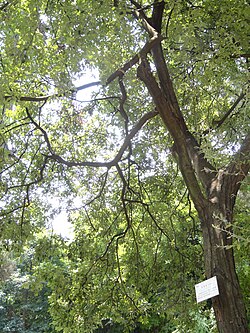| Dichotomanthes | |
|---|---|
 | |
| Dichotomanthes tristaniaecarpa | |
| Scientific classification | |
| Kingdom: | Plantae |
| Clade: | Tracheophytes |
| Clade: | Angiosperms |
| Clade: | Eudicots |
| Clade: | Rosids |
| Order: | Rosales |
| Family: | Rosaceae |
| Subfamily: | Amygdaloideae |
| Tribe: | Maleae |
| Subtribe: | Malinae |
| Genus: | Dichotomanthes Kurz |
| Species: | D. tristaniaecarpa |
| Binomial name | |
| Dichotomanthes tristaniaecarpa | |
Dichotomanthes is a monotypic genus of flowering plants belonging to the family Rosaceae . [1] [2] The sole species is Dichotomanthes tristaniaecarpa. The flower is perigynous (sepals, petals and stamens around the edge of the ovary) the ovary is superior. The fruit of the plant is a dry achene.


